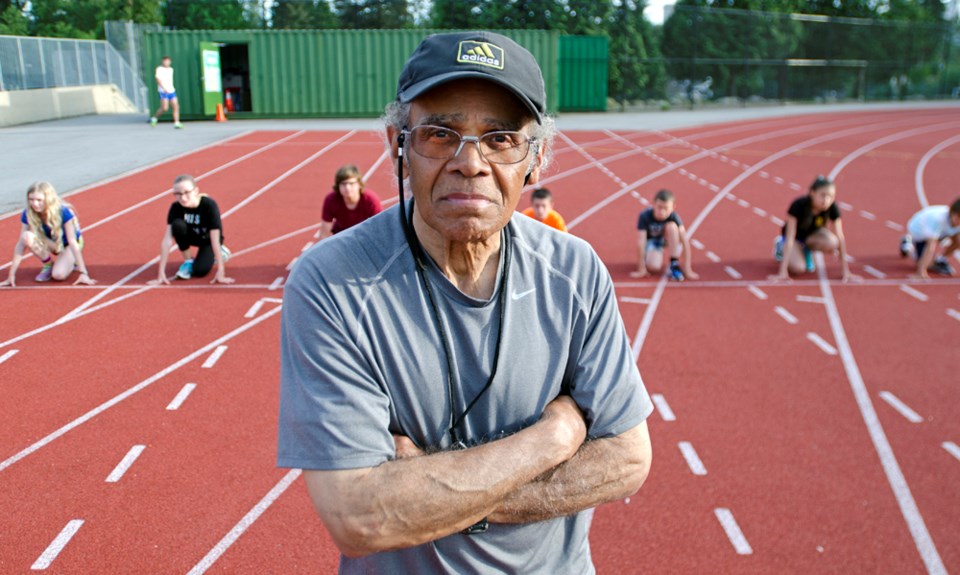Two sports clubs that have run in Burnaby for decades are worried they might have to fold because of rental-rate increases of as much as 900 per cent for school district athletic facilities.
“It’s very disappointing,” said Kyndrie Malmquist, president of the Burnaby Striders Track and Field Club. “We should be encouraging fitness in kids and in the youth, and to have the club possibly dissolve because we can’t afford the fees would be very disappointing.”
The Striders have held winter training sessions on the 200-metre indoor track and in the weight room at Burnaby South Secondary since the school opened in 1993 – and count the likes of former CFL star running back Jon Cornish among their speedy alumni.
The club has seen rental-rate increases of about two or three per cent annually for the facility over the years, according to longtime Striders coach Winston Reckord, but last year he was told his club would have to start paying 10 times more for the facility in the future.
Instead of paying a total of $440 to use the Burnaby South facilities for two hours three times a week from October to March, Reckord was told the Striders would have to pay $4,514.
The district has agreed to implement the Striders’ rate increase gradually over three years, but that’s cold comfort for Reckord.
“It still works out the same way because, at the end of three years, we’re still back to the original figure,” he said.
The Striders coach also questions why the rates the district is now charging for Burnaby South are so high compared to the $693 flat rate the Striders pay the City of Burnaby to rent Burnaby Central’s outdoor track from April to August.
At Burnaby Mountain Secondary, meanwhile, Burnaby Women’s Volleyball found out last spring its gym rental fees would more than triple.
The league has operated in Burnaby for 40 years.
The majority of its players were once Burnaby residents, according to founder Diane Butt, but the number of local players has shifted to below 60 per cent of the league over the years, and the district told organizers last year it therefore would have to start paying the private rental rate.
That will eventually mean an increase from about $40 an hour to about $135 an hour.
The district has deferred the increase until August 2017, but Butt doesn’t think the league will survive past then.
“I’ll be shocked if people will pay that,” she said. “I know I myself wouldn’t pay four times what I’m paying to play volleyball.”
Burnaby Women’s Volleyball fills a special niche in the region, according to Butt, providing an all-female environment that’s competitive – but not too competitive.
“I lived for volleyball. I couldn’t wait every Tuesday to play volleyball,” Butt said.
The league has been around so long, she said, that the daughters of the original players are now the ones playing and organizing teams.
Butt said she’d like to see the school district grandfather the league and give it a chance to keep running.
“My argument with them was I can certainly see this affecting new users but not users that have been with you for 40 years,” she said.
But there’s little chance the district will reverse its decision.
“There’s no plans to, no,” secretary treasurer Greg Frank told the NOW. “We have to be equitable to all of our users out there and make sure that we’re consistent in terms of how we do this.”
The district hasn’t actually changed its fees, Frank said; it has simply centralized the administration of them.
“During that process we identified some users out there that weren’t following our normal fee structure,” he said. “We have a district process with district rates in place, and those have been there historically; however, there have been some historical arrangements in schools that weren’t being caught by our district process, and so we’ve done a thorough review over the last year-and-a-half to two years to make sure that all of our users are going through the right district process.”
A key issue for the district is getting back the money it spends to keep school facilities open, Frank said.
“We have to heat them; we have to clean them; we have wear and tear,” he said. “We aren’t there trying to make a large profit off of anything. We’re just trying to recover part of our costs for making that facility available.”
And, as far as the school district charging more than the city, Frank said that’s the up to city hall.
“The city is choosing to subsidize that,” he said. “How they go about doing that is their business not the school district’s business, but we have to recover our operating costs for these facilities.”



